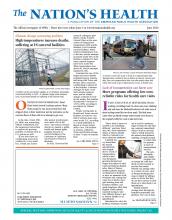
People with IDD can face problems accessing care and negative attitudes when interfacing with U.S. health systems.
Photo by Alex Potemkin, courtesy iStockphoto
Like millions of Americans, Iowa resident Mike Hoenig lined up to get vaccinated during the H1N1 influenza pandemic of 2009.
Other patients in line that day got a written handout explaining the shot’s possible side effects. But it was useless to Hoenig, who is blind, and the nurse said she was too busy to explain it to him. Fortunately, a manager stepped in to help, but Hoenig said the experience is emblematic of how people with intellectual and developmental disabilities like himself are often treated in health settings.
“There’s still a dearth of (health care) training related to disability,” said Hoenig, MA, program coordinator at Iowa’s University Center for Excellence in Developmental Disabilities.
While the U.S. has made considerable inroads to improve health access and outcomes among people with IDD, significant gaps and disparities remain. About 8 million Americans have such disabilities, which are typically present at birth and last throughout a person’s lifetime. They can include both physical and mental impairments due to a range of conditions, such as cerebral palsy, autism and Down syndrome.
Research shows people with IDD experience many disparate health outcomes, including fewer preventive screenings, more complications during pregnancy, lower life expectancy and a high risk of chronic diseases like diabetes. The population also has a long history of suffering discrimination and maltreatment in healthcare, including forced institutionalization.
It was only 25 years ago that the U.S. Supreme Court’s landmark ruling in Olmstead vs. L.C. found that the unjustified segregation of people with disabilities constituted discrimination under the Americans with Disabilities Act. Last year, the National Institutes of Health officially designated people with disabilities as a population with health disparities.
“The fight for people with IDD to live in the community and to live the lives they want to is one that’s ongoing,” said Darcy Milburn, MPH, director for Social Security and health care policy at The Arc, a national nonprofit that advocates for people with IDD. “Discrimination, stigma, exclusion are still rampant in our health care system.”
Remedying the gaps and inequities takes action on many fronts, Milburn told The Nation’s Health, including policy and systems change, more federal and state funding for home- and community-based services, and better training for medical providers. And because people with IDD are, happily, living longer than ever before, the need for robust support systems will only grow, she said.
“There has been so much positive change,” Milburn said. “But there’s so much more that needs to be done.”

Photo by RyanJLane, courtesy iStockphoto
Local work fosters inclusion, equity
Americans with IDD face a range of barriers to health care and health-promoting opportunities, from Medicaid waiting lists to building features that impair people’s mobility. The challenges continue even after they get to the exam room.
In a study published in 2021 in Health Affairs, researchers surveyed about 700 practicing U.S. physicians, more than 82% of whom said that people with significant disability have worse quality of life than people without a disability. Only about 41% of the physicians said they were very confident in their ability to provide the same quality of care to patients with a disability.
Less than 57% of the physicians strongly agreed that they welcomed patients with disabilities into their practices.
“Some (clinicians) just truly don’t believe that some people with disabilities have a quality of life that’s worth continuing,” said Margaret Nygren, EdD, executive director and CEO of the American Association on Intellectual and Developmental Disabilities. “Sadly, it’s still prevalent in the medical field — shockingly so.”
Nygren said the biggest issues people with IDD face in taking care of their health are access and attitudes. She noted that access is deeply intertwined with Medicaid, which provides over 75% of the funding for services for people with IDD.
When health interventions prioritize people with disabilities, better outcomes can follow, she said. For example, a 2021 report from the U.S. Department of Health and Human Services showed that prioritizing people with IDD for vaccination during the COVID-19 pandemic led to high immunization rates among that population.
A number of efforts are aimed at training health providers to better care for people with IDD and recognize their own biases. Hoenig, in Iowa, co-leads a program designed for medical and health professions students at the University of Iowa. The curriculum — now in use for almost 20 years — includes lectures during the first year of medical school and a chance to practice new skills in a staged clinical encounter with people with IDD during the third year.
Hoenig said the training addresses many of his own health care experiences, such as poor communication and providers who assume people with IDD cannot make their own medical decisions.
When Hoenig was diagnosed with cancer about a decade ago, he wanted to bring a friend to his medical appointments for emotional support. But he was worried providers would assume the friend was there to speak for him, as had happened in the past. So he often went alone.
“Overall, what we hear most is that students realize that people with disabilities are people first and much more similar to them than they are different,” Hoenig said about the training.
The Iowa effort used to receive funding from the Centers for Disease Control and Prevention, which has supported a variety of projects aimed at closing health inequities among people with IDD.
“People with disabilities, including people with IDD, need public health programs for the same reasons anyone does — to be healthy, active and part of the community,” JoAnn Thierry, PhD, with CDC’s National Center on Birth Defects and Developmental Disabilities, told The Nation’s Health.
Many of CDC’s efforts focus on policy, systems and environmental changes that integrate the inclusion of people with IDD into community decision-making. Such changes can be more sustainable and impactful over the long term and reach more people, said Karma Edwards, MSPH, a public health consultant at the Center for Advancing Healthy Communities at the National Association of Chronic Disease Directors.
NACDD led a CDC-supported national pilot project — Reaching People with Disabilities through Healthy Communities — that funded five states and 10 communities to make inclusive changes at the local level. An overarching goal was “changing norms and culture around disability and inclusion,” Edwards said.
Overall, the five-year pilot led to more than 600 inclusive policy, systems and environmental changes, according to Edwards. A majority were related to improving built environments to facilitate access to health-promoting public spaces, such as parks and playgrounds. Some specific examples include public wheelchair charging stations, inclusive maps and signage at parks, and auditory beacons at crosswalks.

People with intellectual or developmental disabilities often face barriers in accessing care.
Photo by Ktaylorg, courtesy iStockphoto
“There’s a big difference between something that’s ADA-compliant and something that’s fully inclusive,” Edwards said.
Empowering people with IDD with skills to advocate for their own health is also key, said Celina Urquidez, MPH, education and training senior coordinator at the University of Arizona’s Sonoran Center for Excellence in Disabilities.
Last year, the center debuted “How to Speak Up for Your Health,” which includes more than two dozen videos featuring people with IDD discussing their personal experiences and tips for navigating health systems. The program also has a toolkit, available in English and Spanish, to help people with IDD prepare for medical visits.
“It’s not often we hear from people with disabilities about what’s really happening in health care settings, so it’s very powerful,” Urquidez said.
The center is also hoping to reach public health workers, Urquidez said. In March, it debuted a free, online continuing education course especially for public heath professionals that teaches skills needed to equitably serve and include people with IDD.
“We really want to get at the root of people’s experiences,” Urquidez said.
One root underpinning health for people with IDD is funding for Medicaid community- and home-based services, which enable people to stay as independent as possible. The services — which help with everyday activities such as bathing, preparing food and transportation — were designed as an alternative to institutional care, but are not actual mandates of the Medicaid program, said David Goldfarb, JD, director of long-term supports and services policy at The Arc.
The result, he said, is long waiting lists for services, low reimbursement rates for home health workers, and people going without needed care. As of 2023, according to the Kaiser Family Foundation, almost 700,000 Americans were on waiting lists for Medicaid home- and community-based services, which can cost hundreds of thousands of dollars out of pocket. People with IDD accounted for nearly three-quarters of those on the lists.
Goldfarb said more Medicaid dollars are critical to sustaining and improving health for people with IDD.
“The foundation of independence starts with these services,” he said.
For more information, visit www.thearc.org or https://sonorancenter.arizona.edu.
- Copyright The Nation’s Health, American Public Health Association









